Crossing the Mississippi River between Wisconsin & Iowa (June 2009)
The Cassville Car Ferry (map) crosses the Mississippi River between Cassville, Wisconsin and Turkey River, Iowa. Bridges across the Upper Mississippi are scarce. The river is wide and in these rural areas making it difficult to justify the cost of construction and maintenance of bridge spans.
Residents of Cassville find themselves situated in the middle of a sixty-mile void, having to travel to much larger towns to find a bridge across, either upriver at Prairie du Chien or downriver at Dubuque. A ferry provides the only economic alternative allowing a direct crossing.
Catching the Ferry
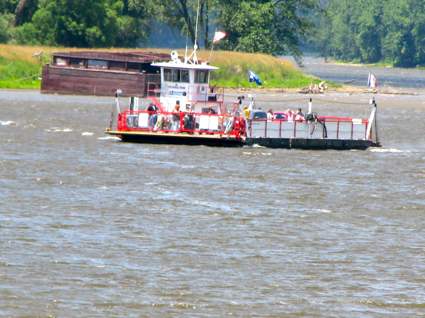
It’s not a large ferry and it hardly seems powerful enough to buck the strong Mississippi currents. Yet, the Cassville Car Ferry travels back-and-forth throughout the day from May though October, delivering passenger vehicles, motorcycles and walk-aboard trekkers from one bank to the other.
It is useful to check their website to confirm that it’s running, especially during the early part of the season. But be aware that the river can be unpredictable even during the summer. Originally I wanted to ride the Cassville Ferry in the summer of 2008 but historic flooding along the Upper Mississippi prevented that. Fortunately I suspected as much and confirmed my hunch by consulting their website so I didn’t travel miles out of my way unnecessarily.
The ferry operates only as frequently as necessary and often waits on the Iowa side of the river during slack times. A notice on the kiosk at Cassville’s Riverside Park instructs riders to turn on a specific light to hail the vessel if it’s sitting idle on the far bank. Someone had already flipped the switch when we arrived so that requirement was covered for our voyage.
Great River Road
It’s a convenient shortcut for local residents, but I wondered how many passengers were actually there to experience a quaint throwback while passing along the Great River Road. That was certainly our reason for boarding. Plus there isn’t all that much on the Iowa side except for an extended patch of dirt road prior to reaching a highway.
Turkey River isn’t actually a town but it does lead to Millville (population 23) and several miles later to Guttenberg (population 2,000). Cassville has a pretty small-town feel too (population 1,100). Perhaps there’s a large enough community of interest between Cassville and Guttenberg to keep the ferry running on its own, but certainly the tourism factor must contribute to its ongoing operation as well.
Operations
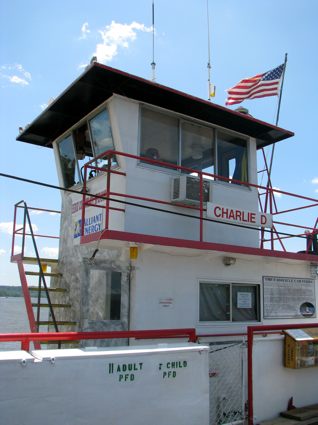
The pilothouse sits off to one side of the vessel rising above the deck. It looks pretty cozy with that air conditioning unit stuck into its side, although hardly necessary on the mild day we crossed. The ship is named ” Charlie D” as can be viewed on the placard on the pilothouse railing, in memory of Charles H. Dietrich who worked hard to return ferry service to Cassville.
The Village of Cassville’s Harbor Commission operates the ferry. With that in mind, it was interesting to see another placard recognizing Alliant Energy as a corporate sponsor. There are many other signs around the edge of the deck in a manner similar to what one would see on the outfield wall of a minor league ballpark. That’s a creative way to subsidize passenger fares which otherwise would be pretty steep. It’s already pretty expensive (although regular users can get quantity discounts).
The Cruise
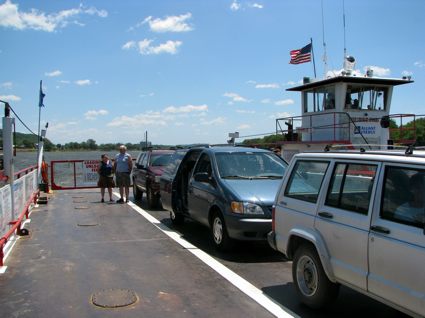
The deck holds only nine cars at a time but that didn’t seem to be a problem on our Sunday afternoon traverse. We shared our ten-minute journey with two other cars and four motorcycles. Passengers left their vehicles to enjoy the fresh air.
We had been considering a river cruise while in La Crosse the previous day but the timing didn’t work out. This was the next best thing. The ferry doesn’t travel straight across the Mississippi River, rather it continues along the river for a mile or so, providing great views as it continues along. In that respect the fare was actually a bargain; a cheap river cruise!
Motorcycles
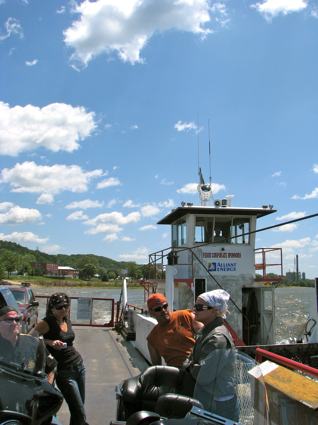
The motorcycle option seemed particularly popular. In fact we’d seen dozens of motorcycle convoys both large to small as we drove along Wisconsin’s portion of the Great River Road. The Cassville Ferry was no exception. We saw motorcycles disembarking as we waited at Riverside Park in Cassville, we rode across the Mississippi River with more of them, and others were waiting on the Iowa side for the return voyage.
I’m guessing that there are probably prearranged riding maps and itineraries available in motorcycling circles that include the ferry as an attractive option. They all seemed to be having a great time so I certainly didn’t mind sharing the road or our cross-river excursion with them.
History
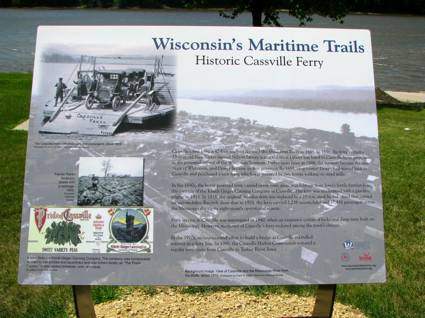
The Cassville Ferry has a long and proud history, which is provided briefly on a plaque at the Riverside Park boat ramp. The text on the plaque reads:
Wisconsin’s Maritime Trails
Historic Cassville FerryCassville’s first ferry, a 40-foot rowboat, crossed the Mississippi River in 1833. In 1836, the ferry carried a 23-year-old New Yorker named Nelson Dewey across the river. Dewey was lured to Cassville by its promise as the potential capital of the Wisconsin Territory. Twelve years later, in 1848, the territory became the new state of Wisconsin, and Dewey became its first governor. By 1858, ex-governor Dewey had moved back to Cassville and purchased a new ferry, which was powered by two horses walking on tread mills.
In the 1890’s, the horse-powered ferry carried sweet corn, peas and cabbage from Iowa’s fertile farmlands to the cannery of the Klindt Geiger Canning Company in Cassville. The ferry was modernized with a gasoline engine in 1913. In 1918, the original, wooden ferry was replaced by a 25-ton, steel-hulled vessel that carried six automobiles. Records show that in 1924, the ferry carried 2,238 automobiles and 17,456 passengers across the Mississippi during its eight-month operational season.
Ferry service in Cassville was interrupted in 1940, when an extensive system of locks and dams were built on the Mississippi. However, memories of Cassville’s ferry endured among the town’s citizens.
In the 1970’s, an unsuccessful effort to build a bridge at Cassville rekindled interest in a ferry line. in 1988, the Cassville Harbor Commission restored a regular ferry route from Cassville to Turkey River, Iowa.
Final Thoughts
We can only imagine how Cassville would appear today had it become the Wisconsin capital. Perhaps it would have evolved like a state capital just a bit further north upriver: St. Paul, Minnesota, part of the Twin Cities of three million people. Cassville would look much different than the sleepy town of the present and more than likely would have had several bridges across the Mississippi River rather than a nine-car ferry. I prefer the ferry, though.
Readers who have an interest in ferries might also want to check my Ferry Index page.

Leave a Reply